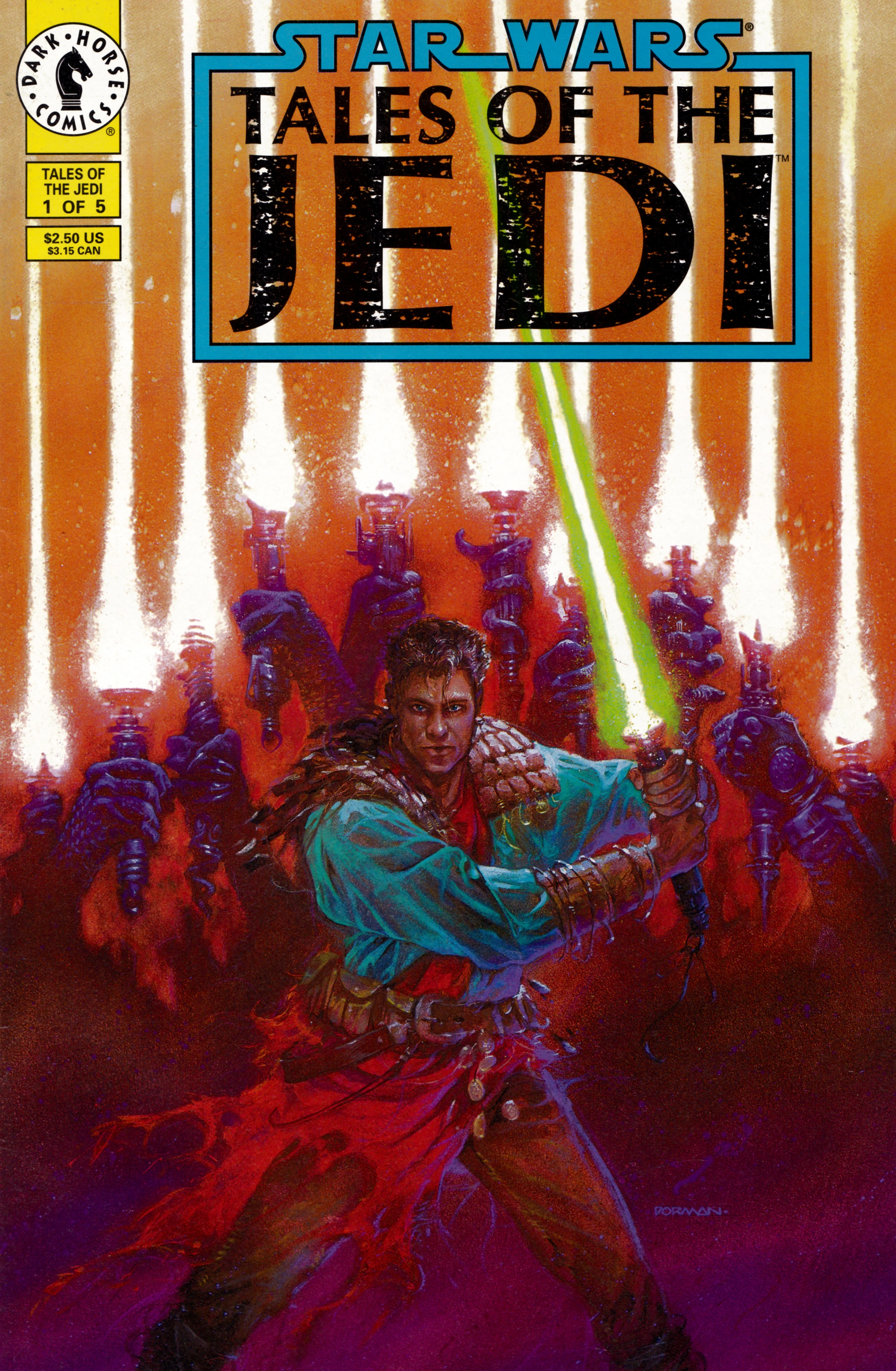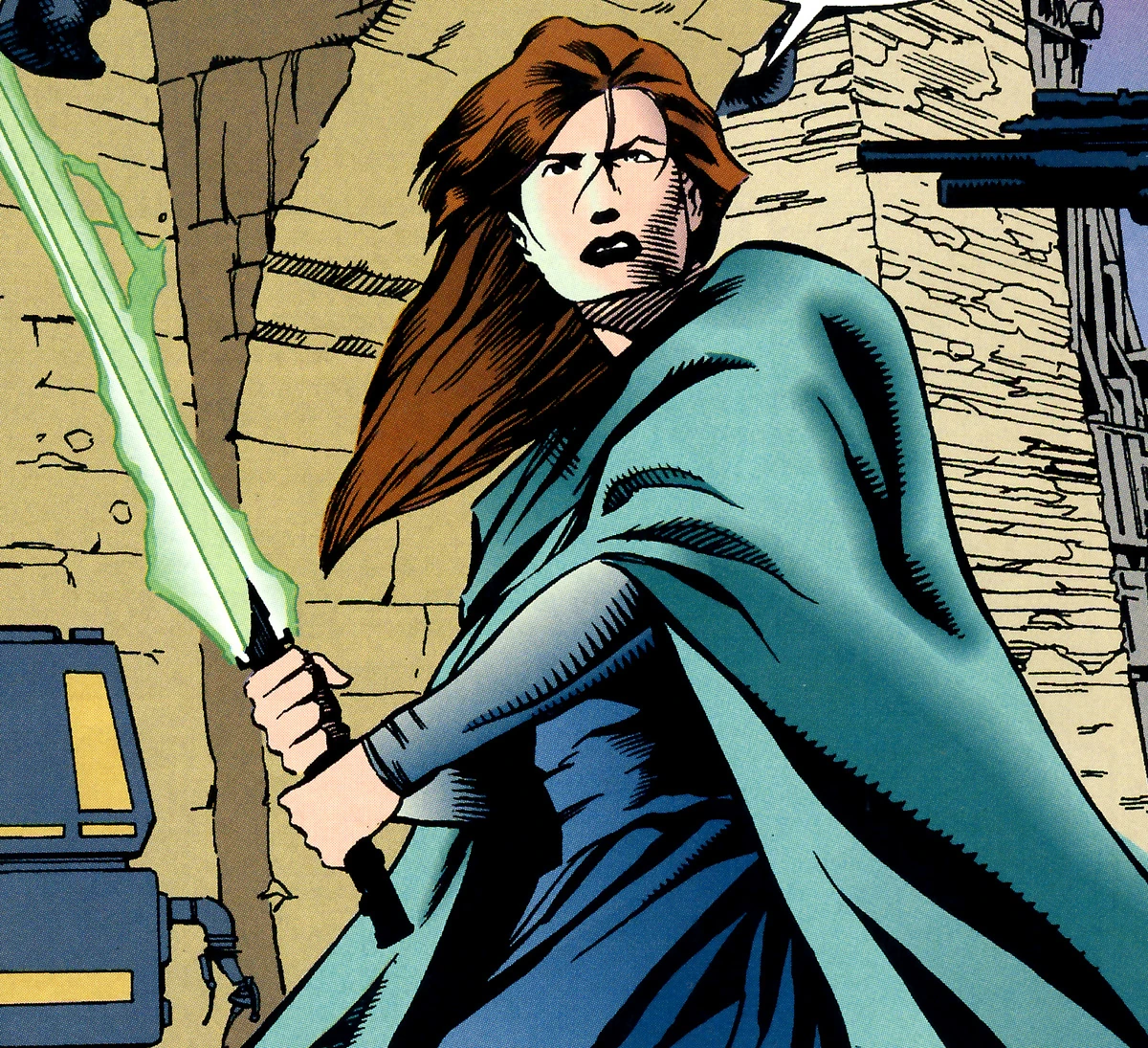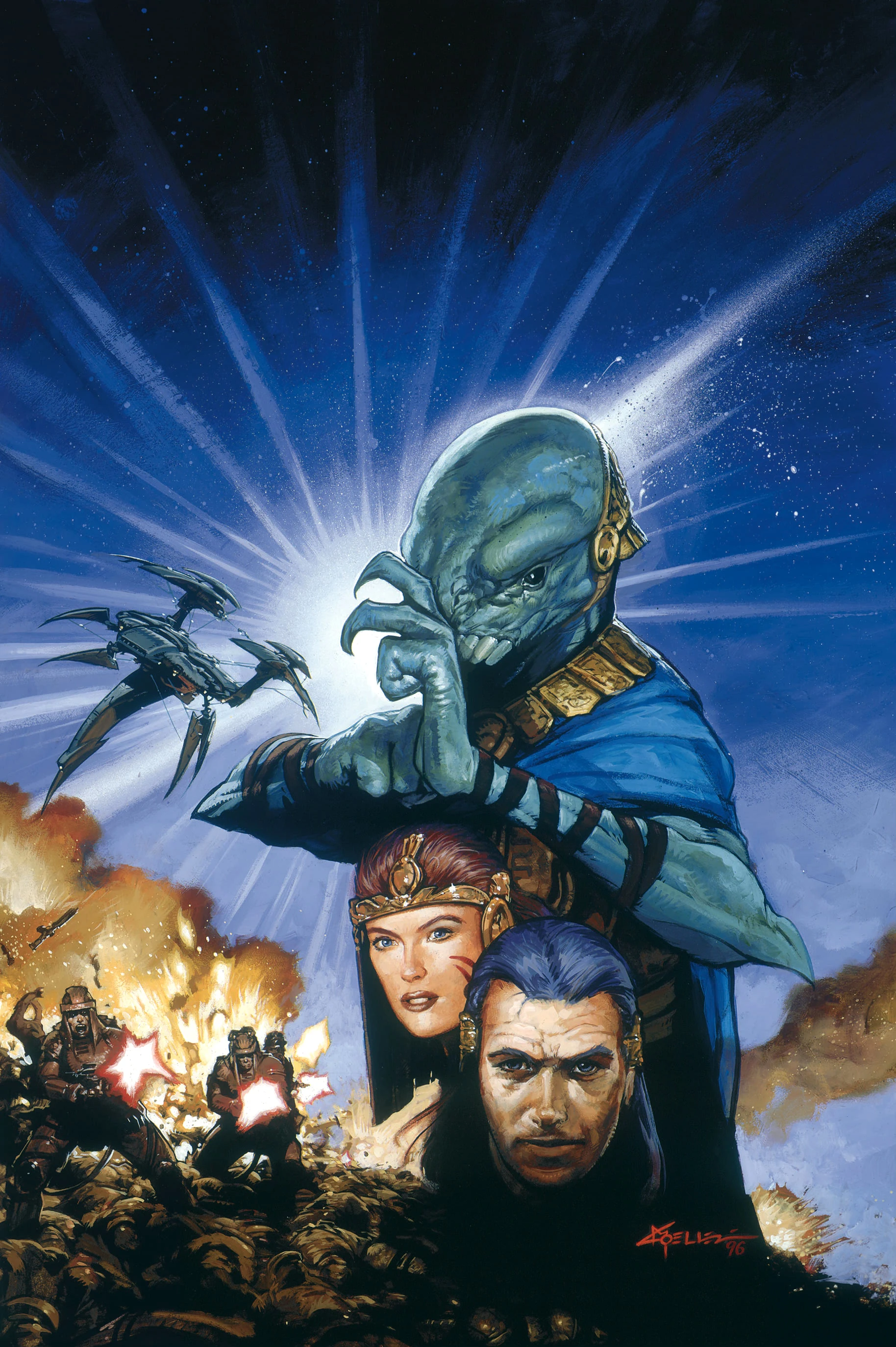As I continue writing about my chronological read-through of Star Wars Legends material, I will now discuss the Tales of the Jedi comics. I actually re-read these first, not as part of a chronological read-through, but because I love these books and occasionally like re-reading them.
I'll be discussing a total of eight titles here (in chronological and reading order):
The Golden Age of the Sith and The Fall of the Sith Empire, tell the story of the Great Hyperspace War, in the year 5,000 BBY. A pair of hyperspace explorers accidentally make contact with the Sith Empire. Millennia earlier, Dark Jedi that had been exiled from Republic space landed on the homeworld of the Sith species, ruled over them, and founded a new Empire led by wielders of the dark side of the Force. The new Dark Lord of the Sith, Naga Sadow, saw the arrival of the two explorers as an opportunity to aggressively expand his Empire, and invaded the Republic. The Jedi and Republic forces managed to stop him, and the Sith Empire would be destroyed.
The remaining arcs tell the story of the Great Sith War, the conflict that saw the re-emergence of the Sith and the Dark Side of the Force, starting around the year 4,000 BBY. First, the groundwork is laid regarding our protagonists, Nomi Sunrider, the initially-reluctant Jedi warrior, and Ulic Qel-Droma, whose overconfidence in his abilities will lead him down a dark path. While Ulic investigates a dark side cult, a troubled Jedi named Exar Kun begins looking into Sith, finding the Dark Lord Freedon Nadd and eventually the lost temple of Naga Sadow. After falling to the dark side, the two wayward Jedi pool their resources and found a new Brotherhood of Sith. They recruit many Jedi Knights, cultists, and the Mandalorians to the cause and wage war against the Republic. They are only stopped when Nomi Sunrider and the remaining good Jedi defeat Exar Kun's forces, leaving his spirit trapped in the ancient temples on Yavin 4. Ulic is defeated by forcibly cutting him off from the Force, though his spirit is redeemed years later with the help of Nomi's daughter.
The story of the Great Sith War was written first. The Great Hyperspace War story was written later as a prequel, picking up threads regarding Naga Sadow and the ancient Sith Lords.
I love these stories of ancient conflict between the Jedi and the Sith. Unlike in Dawn of the Jedi, the Republic and Jedi Order we see in these comics seem familiar. They are clearly not the same entities from the movies (these predate the prequel films), but there is time for the Jedi and Republic to evolve into what we see on screen. It's really fun seeing the original wars between the Jedi and the Sith, that will one day culminate in Darth Sidious having revenge.
I particularly loved the story of the Great Hyperspace War. The story was very small and focussed, the major galactic war taking place generally off-panel. Our focus is on specific characters like the explorers, Gav and Jori; the Dark Lord Naga Sadow and his rival Ludo Kressh; the Jedi Odan-Urr and the Empress of the Koros System, Teta. By paying attention to the most important characters in the conflict, an epic war story becomes a personal tale of heroism and loss.
The Great Sith War stories do the same thing: the war spans the galaxy, but we focus on the personal stories. We read about heroes like Nomi, Arca, Thon, Vodo, and Syvar, villains like Exar and Aleema, and those in between like Ulic. I'm of the view that the Great Hyperspace War story achieve that focus with better success, probably because there were fewer relevant secondary characters in that prequel.
I love the idea that, after finishing the main story of the Great Sith War, the writers thought it would be fun to write a prequel explaining the origin of the Sith Empire and the rise and fall of Naga Sadow. The Great Hyperspace War would go on to be crucial in the backstory of the video game Star Wars: The Old Republic, as well as the Lost Tribe of the Sith short stories.
The story of Exar Kun would feed into the Jedi Academy trilogy of novels, also by Kevin J. Anderson. In the Legends books, Luke Skywalker sets up his Jedi Academy on Yavin 4, in the same temple used as the Rebel base in Episode IV, which happens to be the temple wherein Exar Kun's spirit is trapped. The Jedi elements of those stories were fantastic, setting the stage for Luke's New Jedi Order to grow.
Tales of the Jedi represents an attempt to tell interesting stories about the Old Republic, where light Jedi fought dark Sith for galactic supremacy, informing the conflicts seen in the movies. These are the first stories told in this ancient time period, and would go on to inspire other enjoyable books, comics, and games. I sincerely hope that stories like these will be written for the new Star Wars canon, as it's fun exploring the ancient past of this universe.
These books are not yet available as Marvel Epic Collections, but they are all available on Comixology for purchase and download. It may be possible to track down the Dark Horse omnibuses, but I suspect they are expensive. If you are able to find these stories, I wholeheartedly recommend you read them.
Follow @C_Andrew_H
 |
| The first issue of Tales of the Jedi. Image from Wookieepedia.com |
I'll be discussing a total of eight titles here (in chronological and reading order):
- Tales of the Jedi: The Golden Age of the Sith 0-5 (comic by Kevin J. Anderson, Christian Gossett, and Dario Carrasco Jr., 1996-1997)
- Tales of the Jedi: The Fall of the Sith Empire 1-5 (comic by Kevin J. Anderson and Dario Carrasco Jr., 1997)
- Tales of the Jedi: Ulic Qel-Droma and the Beast Wars of Onderon 1-2 (comic by Tom Veitch and Christian Gossett, 1993)
- Tales of the Jedi: The Saga of Nomi Sunrider 1-3 (comic by Tom Veitch, Janine Johnston, and David Roach, 1993-1994)
- Tales of the Jedi: The Freedon Nadd Uprising 1-2 (comic by Tom Veitch and Tony Akins, 1994)
- Tales of the Jedi: Dark Lords of the Sith 1-6 (comic by Kevin J. Anderson, Tom Veitch, Christian Gossett, and Art Wetherell, 1994-1995)
- Tales of the Jedi: The Sith War 1-6 (comic by Kevin J. Anderson and Dario Carrasco Jr., 1995-1996)
- Tales of the Jedi: Redemption 1-5 (comic written by Kevin J. Anderson and Christian Gossett, 1998).
These comics were all published by Dark Horse Comics. I read them all in Omnibus: Star Wars; Tales of the Jedi Volume 1 and Volume 2.
Story:
There are two main stories told in the Tales of the Jedi comics, each recounting major conflicts between the Jedi and Sith, approximately 1,000 years apart.The Golden Age of the Sith and The Fall of the Sith Empire, tell the story of the Great Hyperspace War, in the year 5,000 BBY. A pair of hyperspace explorers accidentally make contact with the Sith Empire. Millennia earlier, Dark Jedi that had been exiled from Republic space landed on the homeworld of the Sith species, ruled over them, and founded a new Empire led by wielders of the dark side of the Force. The new Dark Lord of the Sith, Naga Sadow, saw the arrival of the two explorers as an opportunity to aggressively expand his Empire, and invaded the Republic. The Jedi and Republic forces managed to stop him, and the Sith Empire would be destroyed.
.jpg/revision/latest?cb=20071207025616) |
| Sith invasion of Coruscant during Great Hyperspace War. Image from Wookieepedia.com |
The remaining arcs tell the story of the Great Sith War, the conflict that saw the re-emergence of the Sith and the Dark Side of the Force, starting around the year 4,000 BBY. First, the groundwork is laid regarding our protagonists, Nomi Sunrider, the initially-reluctant Jedi warrior, and Ulic Qel-Droma, whose overconfidence in his abilities will lead him down a dark path. While Ulic investigates a dark side cult, a troubled Jedi named Exar Kun begins looking into Sith, finding the Dark Lord Freedon Nadd and eventually the lost temple of Naga Sadow. After falling to the dark side, the two wayward Jedi pool their resources and found a new Brotherhood of Sith. They recruit many Jedi Knights, cultists, and the Mandalorians to the cause and wage war against the Republic. They are only stopped when Nomi Sunrider and the remaining good Jedi defeat Exar Kun's forces, leaving his spirit trapped in the ancient temples on Yavin 4. Ulic is defeated by forcibly cutting him off from the Force, though his spirit is redeemed years later with the help of Nomi's daughter.
 |
| Jedi hero Nomi Sunrider. Image from Wookieepedia.com |
Thoughts:
I particularly loved the story of the Great Hyperspace War. The story was very small and focussed, the major galactic war taking place generally off-panel. Our focus is on specific characters like the explorers, Gav and Jori; the Dark Lord Naga Sadow and his rival Ludo Kressh; the Jedi Odan-Urr and the Empress of the Koros System, Teta. By paying attention to the most important characters in the conflict, an epic war story becomes a personal tale of heroism and loss.
 |
| The main heroic characters of the Great Hyperspace War story: Odan-Urr, Jori Daragon, and Gav Daragon. Image from Wookieepedia.com |
The Great Sith War stories do the same thing: the war spans the galaxy, but we focus on the personal stories. We read about heroes like Nomi, Arca, Thon, Vodo, and Syvar, villains like Exar and Aleema, and those in between like Ulic. I'm of the view that the Great Hyperspace War story achieve that focus with better success, probably because there were fewer relevant secondary characters in that prequel.
I love the idea that, after finishing the main story of the Great Sith War, the writers thought it would be fun to write a prequel explaining the origin of the Sith Empire and the rise and fall of Naga Sadow. The Great Hyperspace War would go on to be crucial in the backstory of the video game Star Wars: The Old Republic, as well as the Lost Tribe of the Sith short stories.
The story of Exar Kun would feed into the Jedi Academy trilogy of novels, also by Kevin J. Anderson. In the Legends books, Luke Skywalker sets up his Jedi Academy on Yavin 4, in the same temple used as the Rebel base in Episode IV, which happens to be the temple wherein Exar Kun's spirit is trapped. The Jedi elements of those stories were fantastic, setting the stage for Luke's New Jedi Order to grow.
 |
| Exar Kun, Dark Lord of the Sith, faces off against his Jedi Master. Image from Wookieepedia.com |
Tales of the Jedi represents an attempt to tell interesting stories about the Old Republic, where light Jedi fought dark Sith for galactic supremacy, informing the conflicts seen in the movies. These are the first stories told in this ancient time period, and would go on to inspire other enjoyable books, comics, and games. I sincerely hope that stories like these will be written for the new Star Wars canon, as it's fun exploring the ancient past of this universe.
These books are not yet available as Marvel Epic Collections, but they are all available on Comixology for purchase and download. It may be possible to track down the Dark Horse omnibuses, but I suspect they are expensive. If you are able to find these stories, I wholeheartedly recommend you read them.
Follow @C_Andrew_H
Comments
Post a Comment